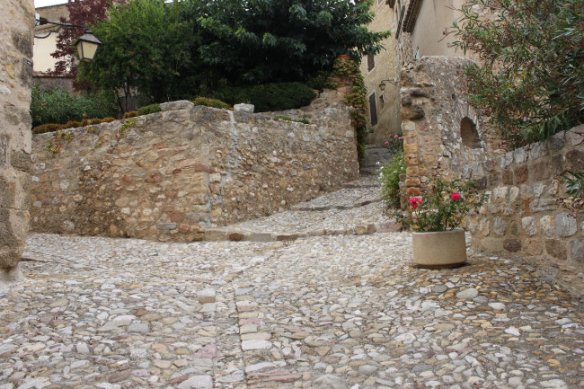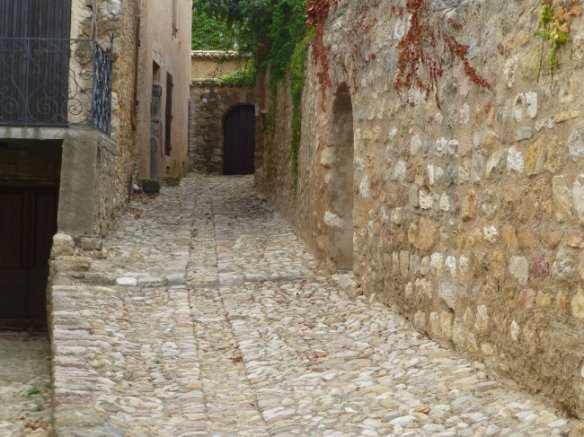It’s amazing what you can discover on walks around the villages in Languedoc! (I know that the area has now been renamed Occitanie, but I refuse to call it that!!) A village which is full of interesting things to discover is Montouliers. It is perched on a hill in the hinterland, not far from Bize Minervois and Argeliers. Walk the narrow streets of the old part of the village up towards the chateau, and with a little imagination you could picture yourself transported back in time.
The narrow streets are paved with stones, a surface which is called calade. Calade is a word that you’ll not find in a French dictionary – it has its roots in the old Gaulish word cal, meaning stone and height. Calades were built using the materials to hand – stones which had been cleared from the fields to make them arable. Skill was required so sort the stones and to place them, so that they would form a durable surface. Mortar was not often used as that would have raised the cost.
Steps were built to shore up the steeper slopes and to allow humans and animals (donkeys and horses in the main) to walk up and down more easily.
In most villages, the calades disappeared with the advent of tarmac in the early 20th century, the old making room for the new. However, in some villages you can still find calades. I know of two small patches in Saint-Chinian.
Here are a few more images from Montouliers – along with the Calades, the exteriors of the houses in the old part of the village have also been carefully renovated!















Beautiful! There are some villages, like Caunes-Minervois, with these stone streets that are too narrow and steep for cars. It’s the only way they avoided being ripped out. Minerve is another one.
LikeLiked by 1 person
I think you’re right, although here they managed to tarmac over pretty much every narrow street and lane in the 1970’s…. 😦
LikeLiked by 1 person
Another enjoyable post. Thank you.
LikeLiked by 1 person
Thank YOU!
LikeLike
Those stones are so delightful to look at….somewhat less, in my experience, to walk on. 🙂
LikeLiked by 1 person
Thank you, Mel!! I was thinking of that, but didn’t get around to putting it in my post!! Sturdy walking shoes are definitely better than sandals on those roads!!
LikeLiked by 1 person
Andreas
Very strange but true.
Earlier today I was looking through some old photographs featuring Justine. There were two showing her and her mum walking up the cobbled bank in Montouliers. Then an hour later I opened your blog!!
What a coincidence. If I knew how to attach a pic I would send you one
xx
Peter
LikeLiked by 1 person
That is a very strange coincidence, Peter – but I’m sure that it was enjoyable too!
LikeLike
Lovely post, Now we have another little place to add to our “must go to” list for when we return to Languedoc. By the way I didn’t know about the change of name to Occitanie. When did that happen? And does it include the Roussillon as well? Of course I should – and will, at some stage – do my own research on this so please don’t feel you must answer!
LikeLiked by 1 person
Hi Wendy, the name change happened last year, after the Languedoc region merged with the Midi Pyrenees region, Roussillon included!
LikeLike